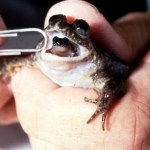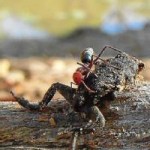toad
Birth of the Gastric Brooding Frog
Photo Mike Tyler
Unfortunately, species are the ultimate bioephemera.
Amphibians in particular have been declining at an alarming rate over the past several decades; some estimates suggest that a third of amphibian species are on the verge of extinction. My latest essay for SEED's website opens with the story of the Gastric Brooding Frog, Rheobatrachus silus, an extremely peculiar species. It was discovered in the 1970s, and already believed extinct just over a decade later. That's barely enough time to describe a species, much less save it.
Save the Frogs…
In the 1930s, Australian ecologists shortsightedly introduced the Cane Toad, a species indigenous to South America, to their isolated continent to eat agricultural pests. This famously proved to be a complete disaster with the toxic toads running rampant and native species poisoning themselves when they tried to make snacks of the delicious, dimwitted amphibians.
Now a team of Australian researchers from the University of Sydney think they may have found an elegant solution that absolutely, positively, cannot backfire into a 1970 C minus horror movie: Meat Ants. The gentle meat ant lives…
"Toad licking" has been well documented around the world with secretions from many species causing intense hallucinations. In this 2006 NPR podcast, they tell the story of a poor cocker spaniel who became addicted to toad. "We noticed Lady (the cocker) spending an awful lot of time down by the pond in our backyard. Late one night after I'd put the dogs out, Lady wouldn't come in. She finally staggered over to me from the cattails. She looked up at me, leaned her head over and opened her mouth like she was going to throw up, and out plopped this disgusting toad." Increasingly Lady would return…
Adorable!
Surinam toads of the family Pipidae have a broad, flat shape and leaf-like appearance, but who cares about that...? They embed fertilized eggs in the mother's back from whence the babies emerge! Adorable? Horrifying? What was your reaction to the movie Alien?
Damn... it looks like Pharyngula beat us to the punch. Whatevs... Surinam Toad stays.
Scientists in Madagascar recently discovered the remains of a giant prehistoric frog, a relative of today's horned toads, which blew away the previous record for the largest known frog, Bennicus Bleimanicus. Dubbed Beelzebufo, meaning "frog from hell," the Devil Frog had important differences from today's frogs. To begin with, it was freakin huge. Susan Evans, a researcher from the University College of London, explained that if it was anything like its closest living forebears, "it would have been quite mean." Considering the fact that it was "the size of a slightly squashed beach-ball,…
An international consortium of zoos, aquariums, conservation organizations and scientists, calling itself the "Amphibian Ark," has dubbed 2008 the "Year of the Frog." Amphibian Ark made the declaration in order to draw awareness to the mass extinction of amphibian species around the globe and to infuriate the Chinese, who already named the year after the rat "like 5000 years ago". The AArk is a joint effort of 3 principal partners: the World Association of Zoos and Aquariums (WAZA), the IUCN/SSC Conservation Breeding Specialist Group (CBSG), and the IUCN/SSC Amphibian Specialist Group (ASG…
Sweden has won the first ever European Bombina Song Contest, in what is surely Europe's most sparsely attended Idol spinoff. Indigenous to the lowlands of Northern Europe, the fire-bellied toad or Bombina bombina is an endangered species that has attracted a small but fanatically loyal fan club of zoologists and ecologists. To bring attention to their conservation efforts, the German organization Stiftung Naturshutz, roughly translated as 'Give Us Money for Nature,' organized a bombina song contest. The heated contest between Sweden, Germany, Denmark and Latvia was fraught with centuries old…
"This bounty hunter is my kind of scum: fearless and inventive." Cane toad, Bufo marinus
The environmental group, Frogwatch, caught one of the largest specimens of toad ever discovered in Darwin, Australia on Tuesday. The apprehended toad is the size of a football and as heavy as a small sack of potatoes.
Cane toads are a highly poisonous, non-native species in Australia and have been wreaking havoc on the local ecosystem for decades. Frogwatch's "Toad Buster" project launches "raids" on small ponds, blinds the toads with bright lights and nets them by the dozens. From there they are killed…

